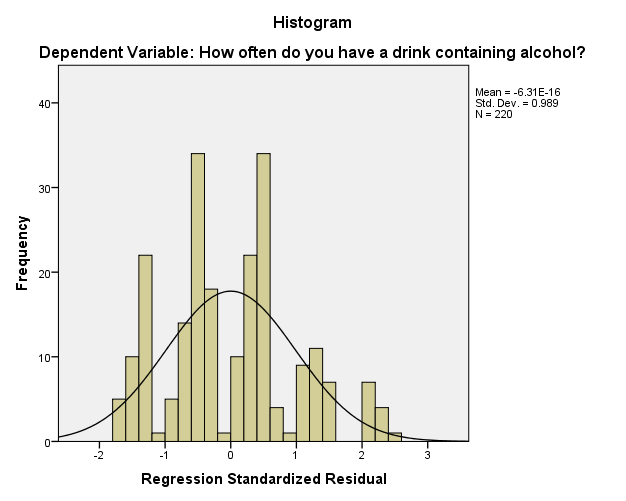In this study, the researchers utilized multiple linear regression to identify the relationship between alcohol consumption and the characteristics of the neighborhood. The dependent variable for this study is alcohol consumption among students (Freitas et al., 2020). The study has five independent variables; firstly, is people often get mugged, robbed, or attacked in the neighborhood. Secondly, people in my neighborhood look out for each other and thirdly, people sold or used drugs in the neighborhood. Fourthly, people in my neighborhood generally got along with each other, and lastly, I feel safe being out alone in my neighborhood during the night.
From table 1.0, the value of R square is 0.026, which means that 2.6% of the variation on students drinking alcohol can be explained by the combined variation of people in neighborhood getting along with each other, people sell or use drugs in the neighborhood, I feel safe being out alone in my neighborhood, people often get mugged, robbed or attacked in my neighborhood, and people in my neighborhood could be trusted. However, the adjusted R square, which considers the number of variables and the sample size, shows that only 0.3% of the variation in the dependent variable can be explained by combined variations of the dependent variable (Ramachandran & Tsokos, 2021).
From table 2.0, the p-value is 0.342, which is greater than 0.05. This means that the regression analysis is not significant to explain the dependent variable using the independent variables (Maneejuk & Yamaka, 2020). From the correlations results in table 3.0; I feel safe being out alone in my neighborhood, people often get mugged, robbed or attacked in my neighborhood, and people in my neighborhood generally got along with each other have a weak positive correlation with how often do you have a drink containing alcohol? People sell or use drugs in my neighborhood, and People in my neighborhood could be trusted has a weak negative correlation with how often do you have a drink containing alcohol? (da Silva Filho et al., 2021).
Table 1.0: Model summary
Table 2.0: ANOVA
Table 3.0: Coefficients

References
da Silva Filho, A., Zebende, G., de Castro, A., & Guedes, E. (2021). Statistical test for multiple detrended cross-correlation coefficient.Physica A: Statistical mechanics and its applications, 562, 125285. Web.
Freitas, H., Henriques, S., Uvinha, R., Lusby, C., & Romera, L. (2020). Alcohol consumption and night-time leisure among Brazilian university students.International Journal of the Sociology of Leisure, 3(4), 389-399. Web.
Maneejuk, P., & Yamaka, W. (2020). Significance test for linear regression: How to test without P-values?Journal of Applied Statistics, 48(5), 827-845. Web.
Ramachandran, K., & Tsokos, C. (2021). Linear regression models. Mathematical Statistics with Applications in R, 301-341. Web.